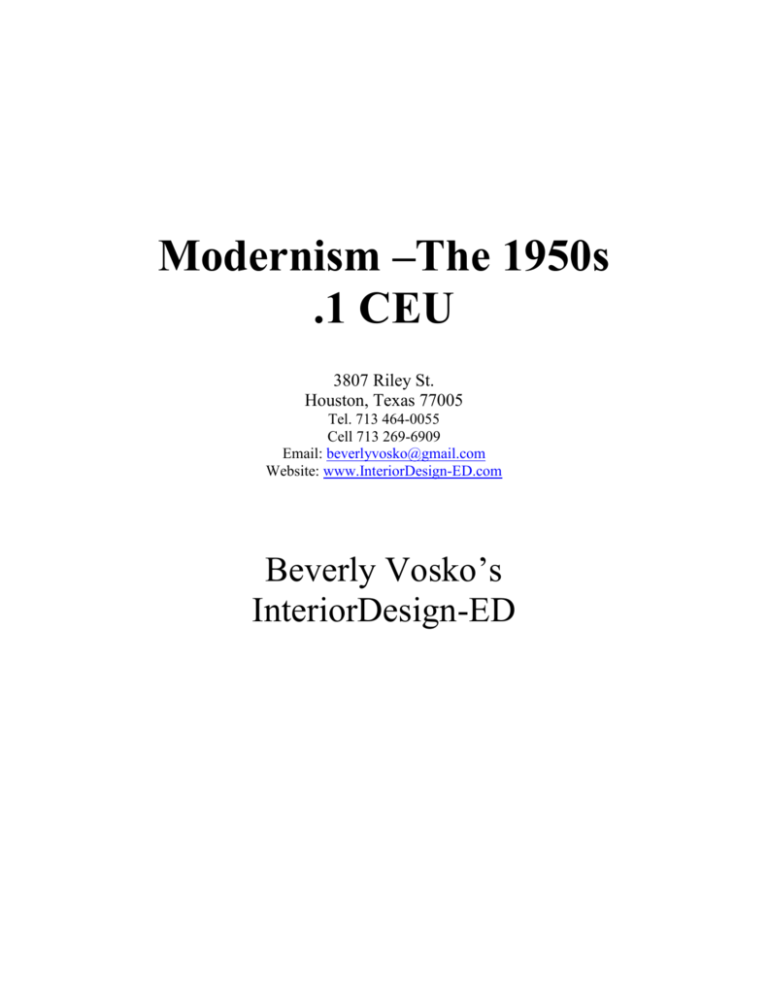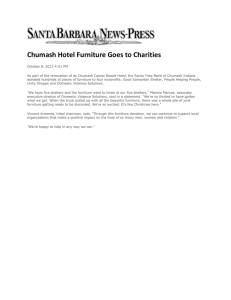
Modernism –The 1950s
.1 CEU
3807 Riley St.
Houston, Texas 77005
Tel. 713 464-0055
Cell 713 269-6909
Email: beverlyvosko@gmail.com
Website: www.InteriorDesign-ED.com
Beverly Vosko’s
InteriorDesign-ED
Modernism – The 1950’s Handouts
Welcome to our 1 hour CEU!
Furniture design experienced more dramatic changes in the 20th Century than at any other time in
its history because in the 20th Century a truly modern notion of furniture evolved which
revolutionized and transformed the traditional attitudes toward furniture that had remained
unchanged since the 18th Century
The fundamental difference between the 20th Century and all the previous centuries is the shift in
emphasis from the hand made to the machine made product…Handcraft and the machine have
fought their battles and in terms of modernism, the machine has surely won
The 1950’s
The Fifties were an exuberant time! By 1950, manufacturing and retail businesses had fully
recovered from the crippling effects of World War II and the West was entering an optimistic era
of consumerism and materialism
The US thrived in its post-war recovery and the 1950’s was an era of unprecedented increases in
production, escalating levels of consumption and prosperity for all
Americans began leaving the urban inner cities in droves and moving to newly created suburbs
and needed inexpensive furniture to fill those homes
These new suburban communities fostered a desire for a casual informal lifestyle which
demanded fluid, easy to live with furniture and a new look which was called the “The
Contemporary Look” went hand in hand with this informal ideology
This new “Contemporary look” was influenced by science, space exploration and new and
improved technologies. The 3 major shaping forces of “The Contemporary Look” were:
1. The firm of Herman Miller under the design directorship of George Nelson who joined the
firm in 1945 and procured several good furniture designers - specifically Charles Eames - to
design mostly office furniture for his firm
2. The firm of Knoll, which continued making furniture by Eero Saarinen and also promoted
the pre-war designs of Mies van der Rohe, Marcel Breuer and others again primarily for office
furniture and
3. The blonde wood and mellow restraint of the Scandinavian style used primarily for
residential homes
Room and furniture designs were innovative for their time—yet endured throughout the following
decades because of their modernity and classic appeal- and are still popular today.
The 1950’s Herman Miller
In the 1950’s Charles Eames designed a whole new range of seating furniture which had a sleeker
profile and a more substantial either cast aluminum or chromium plated steel base. Herman Miller
also brought back Eames’s pre-war low molded armchair and classic Lounge chair and ottoman
and even created tables to match these chairs and manufactured them in the 1950’s as well. All
this furniture was popular in the 1950’s and is still popular and still manufactured by Herman
Miller today.
Herman Miller also manufactured space age avant garde tables such as this glass topped table
with a walnut base by Isamu Noguchi
The 1950’s Knoll
In the 1950’s Knoll began manufacturing various famous pre war designers furniture designs
creating a luxurious understated look for their clients combining some great pre-war classics with
the best of 50’s design
Knolll reissued Mies Van der Rohe’s Barcelona chair as well as his lounge chair and chaise
longue in the 50’s
Knoll also began to manufacture Marcel Breuer’s Wassily chair, cantilevered chair, stacking
nesting tables and Laccio side table and coffee table in the 50’s and still manufactures them all
today
Knoll also continued manufacturing Eero Saarinen’s Tulip chair and Tulip tables, as well as his
Executive chair and Womb chair and still manufactures them today
The 1950’s - Scandinavian Design
After WWII Scandinavian Design flourished and influenced furniture design worldwide,
especially in the U.S.
The major difference between pre-war Modernism and the revived Modernism of the 1950’s was
the addition in the 1950’s of a feeling of discreet luxury and a mellowness which was seldom
present in the pioneering prewar era - and the mellowness and softening of the cold lines was
above all the result of the Scandinavian influences. Scandinavian furniture was usually crafted in
a light blonde wood which was new to the American market and appeared lighter and more
contemporary than the dark woods that had been formerly used by most furniture designers.
The 1950’s – Swedish Design
Carl Malmsten has been described as the father of modern Swedish furniture
His aim inspired partly by national tradition and partly by the theories of the Arts and Crafts
Movement, of harmoniously combining the demands of function and visual pleasure were at the
very basis of the Scandinavian modern style. Malmsten’s simple light wooden furniture in blonde
color tones have in themselves become an allegory for that which is typically Swedish. Both
Malmsten’s and another influential Swede Bruno Mathsson, create furniture which avoided
fashion extremes using a subtle mellow style and soft blonde wood tones.
The 1950’s – Danish Design
Denmark was occupied by the German forces during World War II which led to an introspective
involvement in the craft traditions of woodworking and a revitalization of the Danish
Cabinetmaker’s Guild
Danish furniture became very popular in the 1950’s and “Danish Modern” furniture as we now
call it is one of the most popular styles today
One key person behind the Danish furniture Renaissance was the furniture designer Hans Wegner
Who is known for his graceful furniture designs crafted in blonde wood which were rooted in
tradition yet modern in their functionalism and uncluttered lines. Wegner designed “The Chair” in
1949 and the Presidential Debate chair which was distinguished by the sweeping movement of its
back rail & arms carved as one single form. Wegner also designed and built several other chairs,
sofas, tables and desks all in light blonde wood and all in his subtle mellow style that looks
contemporary yet “homey” and less cold than the other “prewar designs” because it is made in
wood rather than metal. All this furniture was mass produced and exported to Europe and the U.S
and became very popular in the 1950’s
Another very important Danish furniture designer is Arne Jacobsen and he is famous for his
sculptural free form design such as the truly iconic “Egg” and the “Swan” chairs with their
innovative exaggerated organic curves. His furniture designs were manufactured Fritz Hansen in
the 1950’s and they are still manufactured by Fritz Hansen today.
Another important Danish furniture designer is Finn Juhl who designed both sculptural free
formed chairs and sofas and more streamlined chairs, tables and desks in blonde wood tones
Two other important Danish furniture designers were Danes Peter Hvidt and Oria MolgaardNielsen who designed the “AX chair 6003” with a laminated beech frame and a teak seat and
back and won the Diploma of Honor at 2 Milan exhibitions. It too was manufactured by Fritz
Hansen
The 1950’s – Finnish Design
And in the 1950’s several new Finnish furniture designers appeared
Marianne Boman designed furniture in blonde wood tones such as wool covered setees, and
coffee tables which had attached magazine racks and also designed fabric covered chairs with
steel rod bases.
Ilmari Tapiovaara and Antti Nurmesniemi designed chairs in blonde wood with leather upholstery
in typical Scandinavian fashion as well as chairs like the Lukki I which have plywood seats and
backs and tubular steel arms and legs
Finnish furniture designers were more interested in creating series production pieces ie mass
produced furniture and did not place the same emphasis on craft as the Swedes and especially the
Danes did so Finnish furniture never became quite as popular as Swedish and Danish furniture
did
For the first time ever, paint colors were available in any possible hue. (A ’50s advertisement for
Colorizer brand paints declared that their paint was available in 1,322 colors!) so color was used a
great deal!
There were three major color trends in the 50s; pastels, modern and Scandinavian
Popular Pastel colors: pink, turquoise, mint green, pale yellow blue.
Popular Modern colors: vibrant yellow, electric blue, orange, red, black and white
Popular Scandinavian colors: shades of brown, cream, gray and green which were sophisticated
and heavily influenced by nature
1950s design trends fell out of favor over time but are experiencing a renewed popularity today
Today Retro 1950’s design which we call “ Mid Century Modern” is very popular
And several retailers specialize in this style furniture
Bibliography
1. Pile, J. Interior Design 3rd Edition, Pearson/Prentice Hall, Upper Saddle River, New
Jersey, Copyright 2003
2. Garner, Philippe. Twentieth – Century Furniture, Van Nostrand Reinhold , A division of
Litton Educational Publishing, 135 West 50th Street, New York, NY 10020 U.S.A. ,
Copyright by Adkinson Parrish Limited 1980
3. Raizman, David. History of Modern Design Second edition, Laurence King Publishing
Ltd., 361-373 City Road London England Copyright 2010
Biography
Beverly Vosko, RID, ASID (Allied Member) UDCP. CAPS, L.E.E.D Green Associate, TAID,
MBA… is a “Full Service”, Registered Interior Designer in Texas #6333. She is President and
founder of both Beverly Vosko Interiors, and InteriorDesign-ED; both DBA’s for C. V Design
Inc. For over 25 years, she has been designing homes across the United States and Europe,
specializing in creating custom Residential and Commercial environments, be they Traditional,
Transitional, Contemporary or Eclectic, that match her Design clients’ every need, through her
Design Firm, Beverly Vosko Interiors. For over 15 years she has taught Interior Design, Aging in
Place, Green/Sustainable Design, and Antiques at Rice University, the University of Houston, and
for the last 10 years nationally, with her Continuing Education company, InteriorDesign-ED. She
graduated Phi Beta Kappa, Magna Cum Laude from the University of Pennsylvania, studied Art
History at Harvard University, received her MBA in Marketing from NYU Stern Graduate
Business School, and her Design and Antiques training from Sotheby’s and the world renown
Inchbald School of Design. Please check out her websites, www.vosko.com and
www.InteriorDesign-ED.com







